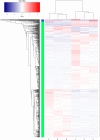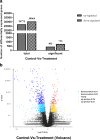RNA-Seq transcriptome analysis of breast muscle in Pekin ducks supplemented with the dietary probiotic Clostridium butyricum
- PMID: 30486769
- PMCID: PMC6264624
- DOI: 10.1186/s12864-018-5261-1
RNA-Seq transcriptome analysis of breast muscle in Pekin ducks supplemented with the dietary probiotic Clostridium butyricum
Abstract
Background: Increased attention is being paid to breast muscle yield and meat quality in the duck breeding industry. Our previous report has demonstrated that dietary Clostridium butyricum (C. butyricum) can improve meat quality of Pekin ducks. However, the potential biological processes and molecular mechanisms that are modulated by dietary C. butyricum in the breast muscle of Pekin ducks remain unknown.
Results: Supplementation with C. butyricum increased growth performance and meat yield. Therefore, we utilized de novo assembly methods to analyze the RNA-Seq transcriptome profiles in breast muscle to explore the differentially expressed genes between C. butyricum-treated and control Pekin ducks. A total of 1119 differentially expressed candidate genes were found of which 403 genes were significantly up-regulated and 716 genes were significantly down-regulated significantly. qRT-PCR analysis was used to confirm the accuracy of the of RNA-Seq results. GO annotations revealed potential genes, processes and pathways that may participate in meat quality and muscle development. KEGG pathway analysis showed that the differentially expressed genes participated in numerous pathways related to muscle development, including ECM-receptor interaction, the MAPK signaling pathway and the TNF signaling pathway.
Conclusions: This study suggests that long-time dietary supplementation with C. butyricum can modulate muscle development and meat quality via altering the expression patterns of genes involved in crucial metabolic pathways. The findings presented here provide unique insights into the molecular mechanisms of muscle development in Pekin ducks in response to dietary C. butyricum.
Keywords: Breast muscle; C. Butyricum; De novo assembly; Pekin duck; RNA-Seq.
Conflict of interest statement
Ethics approval and consent to participate
The present animal study protocol was approved by China Agricultural University Ethics Committee (Permit No. CAU20170505–3) and closely followed the recommendations of the Guidelines for Experimental Animals. Before tissue sampling, all animals were humanely euthanized with sodium pentobarbitone (30 mg/kg BW) anesthesia.
Consent for publication
Not applicable.
Competing interests
The authors declare that they have no competing interests.
Publisher’s Note
Springer Nature remains neutral with regard to jurisdictional claims in published maps and institutional affiliations.
Figures








Similar articles
-
Dietary supplementation with Clostridium butyricum modulates serum lipid metabolism, meat quality, and the amino acid and fatty acid composition of Peking ducks.Poult Sci. 2018 Sep 1;97(9):3218-3229. doi: 10.3382/ps/pey162. Poult Sci. 2018. PMID: 29762790
-
Characterization and comparative transcriptomic analysis of skeletal muscle in female Pekin duck and Hanzhong Ma duck during different growth stages using RNA-seq.Poult Sci. 2023 Dec;102(12):103122. doi: 10.1016/j.psj.2023.103122. Epub 2023 Sep 18. Poult Sci. 2023. PMID: 37832186 Free PMC article.
-
A Discovery of Relevant Hepatoprotective Effects and Underlying Mechanisms of Dietary Clostridium butyricum Against Corticosterone-Induced Liver Injury in Pekin Ducks.Microorganisms. 2019 Sep 16;7(9):358. doi: 10.3390/microorganisms7090358. Microorganisms. 2019. PMID: 31527489 Free PMC article.
-
Centennial Review: History and husbandry recommendations for raising Pekin ducks in research or commercial production.Poult Sci. 2021 Aug;100(8):101241. doi: 10.1016/j.psj.2021.101241. Epub 2021 May 14. Poult Sci. 2021. PMID: 34229220 Free PMC article. Review.
-
Comparison of muscle structure and transcriptome analysis of eyed-side muscle and blind-side muscle in Cynoglossussemilaevis (Osteichthyes, Cynoglossidae).Zookeys. 2025 Mar 6;1230:213-229. doi: 10.3897/zookeys.1230.139837. eCollection 2025. Zookeys. 2025. PMID: 40093692 Free PMC article. Review.
Cited by
-
Transcriptional Insights into Key Genes and Pathways Underlying Muscovy Duck Subcutaneous Fat Deposition at Different Developmental Stages.Animals (Basel). 2021 Jul 15;11(7):2099. doi: 10.3390/ani11072099. Animals (Basel). 2021. PMID: 34359227 Free PMC article.
-
Analysis of genetic structure and identification of important genes associated with muscle growth in Fujian Muscovy duck.Poult Sci. 2024 Dec;103(12):104445. doi: 10.1016/j.psj.2024.104445. Epub 2024 Oct 28. Poult Sci. 2024. PMID: 39504826 Free PMC article.
-
Molecular genetic characterization and meat-use functional gene identification in Jianshui yellow-brown ducks through combined resequencing and transcriptome analysis.Front Vet Sci. 2023 Dec 12;10:1269904. doi: 10.3389/fvets.2023.1269904. eCollection 2023. Front Vet Sci. 2023. PMID: 38179331 Free PMC article.
-
Transcriptome analysis reveals the mechanism by which fermented Broussonetia papyrifera influences meat quality of Taihe black-bone silky fowl.Anim Nutr. 2025 Feb 13;21:365-377. doi: 10.1016/j.aninu.2025.02.002. eCollection 2025 Jun. Anim Nutr. 2025. PMID: 40487112 Free PMC article.
-
Bacteroides vulgatus attenuates experimental mice colitis through modulating gut microbiota and immune responses.Front Immunol. 2022 Nov 30;13:1036196. doi: 10.3389/fimmu.2022.1036196. eCollection 2022. Front Immunol. 2022. PMID: 36531989 Free PMC article.
References
-
- Yang QL, Lou XW, Wang Y, Pan DD, Sun YY, Cao JX. Effect of pH on the interaction of volatile compounds with the myofibrillar proteins of duck meat. Poult Sci. 2017;96(6):1963–1969. - PubMed
-
- Chartrin P, Bernadet MD, Guy G, Mourot J, Hocquette JF, Rideau N, Duclos MJ, Baeza E. Does overfeeding enhance genotype effects on energy metabolism and lipid deposition in breast muscle of ducks? Comp Biochem Physiol A Mol Integr Physiol. 2006;145(4):413–418. doi: 10.1016/j.cbpa.2006.07.024. - DOI - PubMed
MeSH terms
LinkOut - more resources
Full Text Sources

